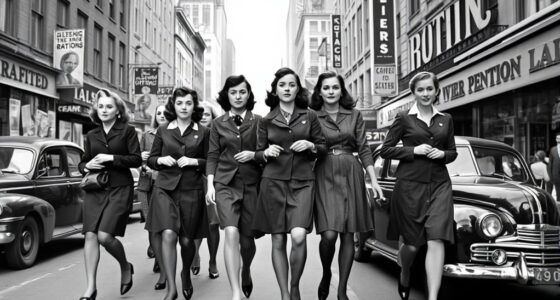Hosiery began thousands of years ago with ancient civilizations using silk stockings that symbolized status and craftsmanship. The Industrial Revolution made mass production possible, turning hosiery more affordable and accessible. Styles evolved from luxurious silk to patterned tights and fishnets, reflecting cultural shifts. Today, innovative textiles like spandex, smart fabrics, and sustainable fibers shape the future of hosiery. If you keep exploring, you’ll discover how technology continues to transform this timeless accessory.
Key Takeaways
- Ancient silk stockings in China showcased early luxury and advanced weaving techniques for elite wear.
- The Industrial Revolution introduced knitting machines, enabling mass production and wider accessibility of hosiery.
- Hosiery styles evolved from silk luxury to fashionable patterned tights and rebellious fishnets reflecting cultural shifts.
- Technological innovations like spandex and smart fabrics enhanced durability, stretch, and integrated wearable features.
- Future trends focus on sustainable materials and smart textiles for health monitoring and eco-friendly fashion.
The Birth of Hosiery: Ancient Origins and Early Silk Stockings

Hosiery has roots that stretch back thousands of years, with ancient civilizations recognizing the importance of leg coverings. Early textiles served practical and decorative purposes, often made from natural fibers. Among these, silk craftsmanship stood out, especially in ancient China, where silk was highly valued. Skilled artisans created delicate, luxurious stockings from silk, which were reserved for the elite. These early silk stockings showcased advanced weaving techniques and a keen eye for detail. As trade routes expanded, the reputation of silk stockings grew, influencing other cultures to develop their own versions. While these textiles were rare and expensive, they marked the beginning of hosiery as a symbol of status and craftsmanship. The development of woven textiles contributed significantly to the evolution of hosiery, reflecting both technological progress and social significance. Your journey into hosiery’s history begins with these ancient textiles and the mastery behind silk craftsmanship.
Industrial Revolution and Mass Production of Hosiery

The Industrial Revolution dramatically transformed the production of hosiery, shifting it from handcrafted artisans to large-scale factories. This change sped up textile manufacturing, making hosiery more affordable and accessible. Factories introduced machines that increased efficiency and uniformity, reducing the time needed to produce each pair. As production grew, labor unions emerged to advocate for workers’ rights amid often harsh conditions. You might notice how innovations like knitting machines revolutionized the industry, enabling mass production. The rise of factories also led to urbanization, drawing workers from rural areas. The shift from manual to mechanized production marked a pivotal moment, making hosiery widely available and setting the stage for future fashion trends. This era truly laid the groundwork for modern hosiery manufacturing. Understanding industry trends also played a crucial role in shaping the evolution of hosiery production methods.
Iconic Styles and Fashion Statements in the 20th Century

As fashion evolved throughout the 20th century, hosiery became a powerful tool for making bold style statements and reflecting changing societal attitudes. You saw how stockings shifted from the luxurious silk of the early 1900s to more accessible materials, symbolizing the lingerie evolution. Different styles conveyed cultural symbolism: the classic black sheer stockings represented sophistication, while patterned tights challenged conventions and embraced individuality. Hosiery choices often mirrored societal shifts, from the flapper’s daring fishnets to the conservative nylons of the 1950s. To illustrate, consider this table:
| Style | Era | Cultural Significance |
|---|---|---|
| Silk Stockings | Early 20th Century | Luxury and femininity |
| Fishnets | 1920s-30s | Rebellion and freedom |
| Patterned Tights | 1960s-70s | Self-expression and progress |
Hosiery became more than clothing; it was a cultural statement. Additionally, advancements in fabric technology expanded the variety and accessibility of hosiery options for different audiences.
Technological Innovations: From Spandex to Smart Fabrics

Technological advancements have revolutionized hosiery, transforming it from simple fabric coverings into innovative, high-performance garments. Today, fiber blending enhances elasticity and comfort, making tights more resilient and flexible. Smart fabrics incorporate sensors to monitor health or adapt to temperature changes, pushing the boundaries of what hosiery can do. Spandex revolutionized the industry by providing exceptional stretch, while ongoing innovations improve textile durability, ensuring longer-lasting wear. These developments allow you to enjoy hosiery that fits better, lasts longer, and offers new functionalities.
Technological innovations have transformed hosiery into durable, flexible, and smart garments with enhanced comfort and functionality.
- Fiber blending improves elasticity and durability
- Textiles now incorporate smart sensors and responsive features
- Spandex introduced superior stretch and recovery
- Enhanced textile durability extends product lifespan
- Hackathons foster innovation and collaboration in developing new textile technologies.
The Future of Hosiery: Integrating Technology and Sustainable Practices

Innovations in textile technology are paving the way for a more sustainable and connected future in hosiery. You’ll see brands increasingly using sustainable fibers like recycled nylon and bio-based materials, reducing environmental impact. Wearable technology is also becoming integrated into hosiery, allowing for features like temperature regulation, moisture control, and health monitoring. These smart tights can track your activity or provide real-time feedback on circulation, making them both functional and fashionable. As consumers demand eco-friendly options, manufacturers are investing in eco-conscious practices and innovative textiles. The future of hosiery isn’t just about style; it’s about combining sustainability with tech-driven comfort and convenience. You’ll benefit from products that are not only better for the planet but also enhance your daily life through smarter, more sustainable design. Additionally, the integration of wearable technology into hosiery is opening new possibilities for health and performance tracking, making these products increasingly popular among active consumers.
Frequently Asked Questions
How Did Hosiery Influence Social Status Historically?
Hosiery historically influenced social status by serving as a symbol of wealth and sophistication. You could easily distinguish the ranks of aristocracy through their fashion choices, especially their luxurious silk stockings. Wearing fine hosiery signified higher social standing and adherence to fashion symbolism, setting the elite apart from lower classes. Over time, hosiery became more accessible, but it initially reinforced social hierarchies and emphasized the importance of appearance in societal rank.
What Cultural Variations Exist in Hosiery Styles Worldwide?
You’ll notice that cultural symbolism and regional preferences shape hosiery styles worldwide. In Japan, tabi socks with thonged sandals reflect traditional attire, while in Nigeria, vibrant, patterned tights showcase cultural identity. In Italy, sheer stockings symbolize elegance, and in India, colorful, embroidered hosiery complements festive wear. These variations highlight how hosiery adapts to cultural meanings and regional tastes, making it a unique expression of identity across different societies.
How Have Hosiery Marketing Strategies Evolved Over Centuries?
You might be surprised to learn that hosiery marketing has shifted remarkably over centuries, emphasizing luxury branding and advertising innovation. Initially, ads focused on practicality, but now they evoke emotion and aspiration. Today, brands use social media influencers and immersive campaigns to reach consumers, transforming hosiery from simple necessity to a fashion statement. This evolution highlights how marketing strategies adapt to cultural trends, making hosiery appealing across diverse markets worldwide.
Are There Hidden Symbols or Meanings in Historical Hosiery Designs?
You might find hidden messages or symbolic motifs in historical hosiery designs that reflect social status, political messages, or personal beliefs. These subtle symbols often served as a form of communication or identity, especially when overt expression was restricted. By examining intricate patterns or specific motifs, you can uncover layers of meaning, revealing how hosiery was more than just fashion—it was a medium for conveying secret messages and cultural values.
What Are the Environmental Impacts of Hosiery Manufacturing Today?
Ever wonder how your hosiery choices affect the planet? Today, manufacturing hosiery involves significant manufacturing emissions and the use of non-sustainable fibers. But by choosing products made from sustainable fibers, you can reduce environmental impacts. Companies are increasingly adopting eco-friendly practices, yet the industry still faces challenges. Your awareness and demand for greener options can drive positive change and help lessen the environmental footprint of hosiery production.
Conclusion
Hosiery has come a long way, from ancient silk stockings to today’s smart, sustainable designs. Did you know that the global hosiery market is expected to reach over $20 billion by 2027? As technology and eco-friendly practices continue to evolve, you’ll see even more innovative styles that blend fashion with function. So, whether you’re into classic tights or high-tech fabrics, the future of hosiery promises exciting, stylish, and sustainable options for everyone.









